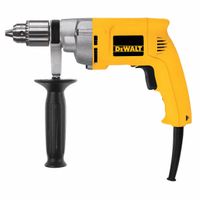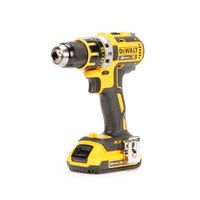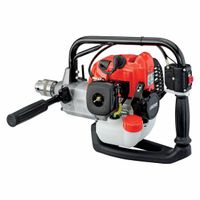Call +(254) 703 030 000 / 751 483 999 / 721 704 777
- Home
- Tools
- Power Tools
- Drills Drivers
- Pistol Grip Drills
.....Read More
Frequently Asked Questions
What is a pistol-grip drill used for?
A pistol-grip drill is a versatile power tool primarily used for drilling holes in various materials such as wood, metal, plastic, and masonry. Its design, resembling the handle of a pistol, provides ergonomic comfort and control, making it suitable for both professional and DIY applications.
Key uses include:
1. **Drilling Holes**: The primary function is to create precise holes for screws, bolts, or other fasteners. It can accommodate different drill bit sizes and types, allowing for versatility in hole diameter and depth.
2. **Driving Screws**: With the appropriate bit, it can drive screws into materials, making it useful for assembly and construction tasks.
3. **Mixing Materials**: By attaching a mixing paddle, it can mix paint, mortar, or other substances, providing a consistent blend.
4. **Sanding and Polishing**: With sanding or polishing attachments, it can be used for surface finishing tasks, smoothing out rough edges or polishing surfaces.
5. **Countersinking and Counterboring**: It can create countersinks or counterbores for flush or recessed screw heads, enhancing the aesthetic and functional quality of a project.
6. **Hole Sawing**: When equipped with a hole saw attachment, it can cut larger diameter holes, useful for plumbing or electrical installations.
7. **Wire Brushing**: With a wire brush attachment, it can remove rust, paint, or other surface contaminants from metal or other materials.
The pistol-grip design allows for better maneuverability in tight spaces and provides a stable grip, reducing user fatigue during extended use. It is a staple tool in construction, woodworking, metalworking, and home improvement projects due to its adaptability and ease of use.
How does a pistol-grip drill differ from other drills?
A pistol-grip drill is characterized by its handle design, which resembles the grip of a pistol. This ergonomic design allows for better control and comfort during use, especially for prolonged periods. The main differences between a pistol-grip drill and other types of drills, such as right-angle drills or hammer drills, lie in their design, intended use, and functionality.
1. **Design and Ergonomics**: The pistol-grip drill features a handle that is perpendicular to the drill body, providing a natural grip that aligns with the user's wrist. This design reduces strain and enhances maneuverability, making it suitable for general-purpose drilling tasks.
2. **Intended Use**: Pistol-grip drills are typically used for light to medium-duty tasks, such as drilling holes in wood, metal, or plastic, and driving screws. They are ideal for home improvement projects and general maintenance work.
3. **Size and Portability**: These drills are generally compact and lightweight, making them easy to handle and transport. Their size allows for use in tight spaces where larger drills might not fit.
4. **Power Source**: Pistol-grip drills can be corded or cordless. Cordless models offer greater mobility and are powered by rechargeable batteries, while corded versions provide continuous power without the need for recharging.
5. **Speed and Torque**: While pistol-grip drills offer variable speed settings, they typically have less torque compared to more specialized drills like hammer drills, which are designed for heavy-duty tasks such as drilling into concrete or masonry.
6. **Versatility**: The pistol-grip design is versatile for a wide range of applications, but it may not be suitable for tasks requiring high torque or precision in confined spaces, where right-angle drills or other specialized drills would be more appropriate.
What are the advantages of using a pistol-grip drill?
A pistol-grip drill offers several advantages that make it a popular choice for both professional and DIY users:
1. **Ergonomic Design**: The pistol-grip design provides a comfortable and natural hand position, reducing strain and fatigue during prolonged use. This ergonomic advantage allows for better control and precision.
2. **Versatility**: Pistol-grip drills are versatile tools suitable for a wide range of applications, including drilling holes, driving screws, and even mixing materials with the appropriate attachments. They can be used on various materials such as wood, metal, and plastic.
3. **Compact Size**: The compact and lightweight nature of pistol-grip drills makes them easy to handle and maneuver in tight or confined spaces, where larger drills might be cumbersome.
4. **Control and Stability**: The design allows for better balance and control, which is crucial for tasks requiring precision. The grip provides stability, reducing the likelihood of slipping or misalignment during operation.
5. **Variable Speed Control**: Many pistol-grip drills come with variable speed settings, allowing users to adjust the speed according to the task at hand. This feature enhances control and efficiency, especially when working with different materials.
6. **Ease of Use**: The intuitive design makes pistol-grip drills user-friendly, even for beginners. The trigger mechanism is easy to operate, and the forward/reverse switch is typically within easy reach.
7. **Portability**: Being generally cordless, many pistol-grip drills offer the advantage of portability, allowing users to work in locations without easy access to power outlets.
8. **Affordability**: Pistol-grip drills are available in a wide range of prices, making them accessible to both hobbyists and professionals. They offer good value for money given their functionality and durability.
Are corded or cordless pistol-grip drills better?
Corded and cordless pistol-grip drills each have their advantages and disadvantages, making them suitable for different situations.
Corded drills are typically more powerful and provide a consistent power supply, which is ideal for heavy-duty tasks and prolonged use. They are generally lighter than cordless models since they don't carry a battery, making them easier to handle for extended periods. However, their mobility is limited by the length of the power cord, and they require access to an electrical outlet, which can be inconvenient in remote locations.
Cordless drills offer greater flexibility and portability, as they are not tethered to a power source. This makes them ideal for use in areas without easy access to electricity or for quick jobs around the house. Modern cordless drills have improved significantly in terms of power and battery life, with lithium-ion batteries providing longer run times and faster charging. However, they are typically heavier due to the battery and may not deliver the same consistent power as corded models, especially as the battery depletes.
In summary, if you need a drill for heavy-duty, continuous work and have access to power outlets, a corded drill is likely the better choice. If you prioritize mobility and convenience for lighter tasks or work in areas without reliable power, a cordless drill would be more suitable.
How do you maintain a pistol-grip drill?
1. **Cleaning**: After each use, wipe down the exterior with a clean cloth to remove dust and debris. Use compressed air to blow out dust from vents and crevices.
2. **Inspecting**: Regularly check the power cord for any signs of wear or damage. Ensure the plug is intact and the cord is free from cuts or frays.
3. **Lubrication**: Periodically apply a few drops of machine oil to the chuck to ensure smooth operation. If the drill has a gearbox, refer to the manual for lubrication instructions.
4. **Checking the Chuck**: Ensure the chuck is functioning properly by opening and closing it without resistance. Tighten and loosen a drill bit to confirm it holds securely.
5. **Battery Maintenance**: For cordless drills, charge the battery fully before storage. Avoid leaving the battery in the charger for extended periods. Store batteries in a cool, dry place.
6. **Bit Maintenance**: Regularly inspect drill bits for wear and replace them if they are dull or damaged. Store bits in a protective case to prevent damage.
7. **Storage**: Store the drill in a dry, dust-free environment. Use a case or bag to protect it from moisture and impacts.
8. **Calibration**: Occasionally check the drill’s alignment and performance. If it’s not drilling straight, it may need professional servicing.
9. **Safety Checks**: Ensure all safety features, like the trigger lock, are functioning correctly. Replace any worn or damaged parts immediately.
10. **Manual Reference**: Always refer to the manufacturer’s manual for specific maintenance guidelines and troubleshooting tips.
What safety precautions should be taken when using a pistol-grip drill?
1. **Read the Manual**: Familiarize yourself with the manufacturer's instructions and safety guidelines.
2. **Wear Protective Gear**: Use safety goggles to protect your eyes from debris, ear protection to guard against noise, and gloves to enhance grip and protect your hands.
3. **Inspect the Drill**: Check for any damage or wear on the drill, cord, and plug. Ensure the drill bit is sharp and properly secured.
4. **Secure the Workpiece**: Use clamps or a vise to hold the material in place, preventing movement during drilling.
5. **Check the Environment**: Ensure the work area is clean, dry, and well-lit. Remove any tripping hazards and ensure proper ventilation.
6. **Use the Right Drill Bit**: Select the appropriate bit for the material and task. Ensure it is compatible with the drill's speed and power.
7. **Adjust Speed and Torque**: Set the drill to the correct speed and torque for the material to prevent bit breakage or material damage.
8. **Maintain a Firm Grip**: Hold the drill with both hands, using the pistol grip for control and stability.
9. **Avoid Loose Clothing and Jewelry**: These can get caught in the drill, leading to injury.
10. **Keep Cords Clear**: Ensure the power cord is out of the drilling path to prevent cutting or tangling.
11. **Drill Perpendicular**: Keep the drill bit perpendicular to the work surface to ensure straight holes and prevent bit breakage.
12. **Apply Steady Pressure**: Use consistent pressure without forcing the drill, allowing the bit to do the work.
13. **Unplug When Not in Use**: Disconnect the drill when changing bits or when not actively drilling.
14. **Stay Alert**: Be aware of your surroundings and maintain focus to prevent accidents.
Can a pistol-grip drill be used for both drilling and driving screws?
Yes, a pistol-grip drill can be used for both drilling and driving screws, but with some considerations. Pistol-grip drills are versatile tools primarily designed for drilling holes in various materials like wood, metal, and plastic. However, they can also be adapted for driving screws with the right accessories and settings.
To use a pistol-grip drill for driving screws, you need to ensure it has a variable speed control and a reversible motor. Variable speed allows you to adjust the drill's speed to suit the task, while the reverse function helps in removing screws. Additionally, using a clutch setting, if available, can prevent overdriving screws and damaging the material.
For driving screws, it's essential to use the correct screwdriver bit that fits the screw head properly. Many pistol-grip drills come with a keyless chuck, making it easy to switch between drill bits and screwdriver bits. Magnetic bit holders can also be used to hold the screws in place, making the task more efficient.
However, there are limitations. Pistol-grip drills are generally bulkier and heavier than dedicated screwdrivers or impact drivers, which can make them less comfortable for prolonged use or in tight spaces. They also lack the torque control and impact mechanism found in impact drivers, which are specifically designed for driving screws, especially into tougher materials.
In summary, while a pistol-grip drill can be used for both drilling and driving screws, it may not be as efficient or comfortable as using a dedicated tool for each task. For occasional use, it is a practical solution, but for frequent or heavy-duty screw driving, a dedicated impact driver or cordless screwdriver might be more suitable.


